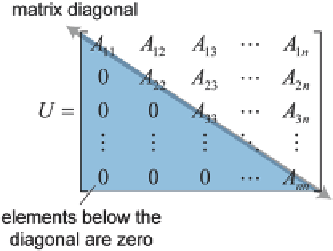Biomedical Engineering Reference
In-Depth Information
elements
A
31
,
A
41
, ….,
A
n
1
in the first column of matrix
A
are treated similarly by
repeating this process down the first column (e.g. Row3- Row1
×
A
31
/
A
11
), so that
all the elements below
A
11
are reduced to zero. The same procedure is then applied
for the second column, (for all elements below
A
22
) and so forth until the process
reaches the
n
-1
th
column. Note that at each stage we need to divide by
A
nn
and there-
fore it is imperative that the value is non-zero. If it is not, then row exchange with
another row below that has a non-zero needs to be performed.
After this process is complete, the original matrix
A
becomes an
upper triangu-
lar matrix
that is given by:
AAA A
AA A
A
11
12
13
1
n
0
22
23
2
n
U
=
0
A
33
3
n
000
A
nn
All the elements in the matrix
U
except the first row differ from those in the original
matrix
A
and our systems of equations can be rewritten in the form:
UB
φ=
The upper triangular system of equations can now be solved by the
Back Substitu-
tion
process. The last row of the matrix
U
contains only one non-zero coefficient,
A
nn
, and its corresponding variable
ϕ
n
is solved by
B
U
n
φ =
n
nn
The second last row in matrix
U
contains only the coefficients
A
n-
1,
n
and
A
nn
and,
once
ϕ
n
is known, the variable
ϕ
n−
1
can be solved. By proceeding up the rows of the
matrix we continue substituting the known variables and
ϕ
i
is solved in turn. The
general form of equation for
ϕ
i
is expressed as:
n
∑
B
−
A
φ
i
ij
j
ji
=+
1
φ
=
(5.76)
i
A
ii
It is not difficult to see that the bulk of the computational effort is in the
forward
elimination
process; the back substitution process requires less arithmetic opera-
tions and is much less costly. Gaussian elimination can be expensive especially for


Search WWH ::

Custom Search